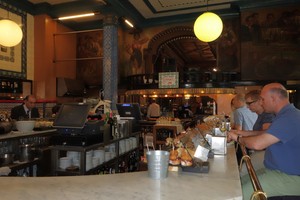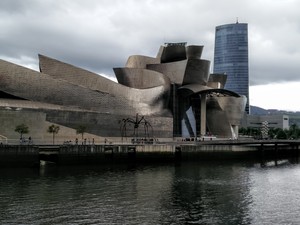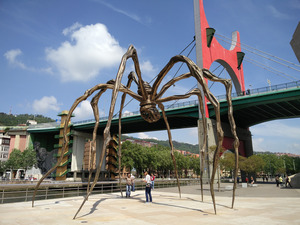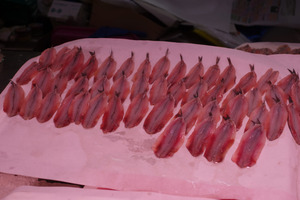In Bilbao you never need to sit down for a full blown meal. Grazing is a way of life. Simply saunter from bar to bar, ordering a beer or a glass of wine and choosing a couple of pintxos in each. Pintxos are what the Basques call tapas. But while you may think of tapas mostly as hors d’oeuvres to a dinner that starts when most of us are contemplating bed, these little beauties can be the main event. And while in the rest of Spain you may still get tapas free, you invariably pay a small amount for each – though an entire evening drinking and sampling them needn’t set you back more than about £25 for two.
 Each bar has its speciality. They may include bacalao or cod, perhaps cooked in pil pil sauce with garlic and hot little peppers, goat cheese with quince paste called membrillo, or various varieties of the more obviously Spanish tortilla. They say that if you sit in one place and fill up you stand out as a tourist. Locals eat one or two and move on. They seem to come and go in waves. Good places to look like locals include the Licenziado Poza in the new town, a few streets back from the Gran Via Don Diago Lopez de Haro near the Dagrado Corazon monument. Slightly more touristy, though with a huge choice of bars, is the elegant, arcaded Plaza Nueva in the Old Town. And you shouldn’t leave without popping into the Cafe Iruna, with its wall tiles advertising sherry and anis, whose head barman remembers divers orders, directs staff and serves in a constant whirlwind of near operatic activity.
Each bar has its speciality. They may include bacalao or cod, perhaps cooked in pil pil sauce with garlic and hot little peppers, goat cheese with quince paste called membrillo, or various varieties of the more obviously Spanish tortilla. They say that if you sit in one place and fill up you stand out as a tourist. Locals eat one or two and move on. They seem to come and go in waves. Good places to look like locals include the Licenziado Poza in the new town, a few streets back from the Gran Via Don Diago Lopez de Haro near the Dagrado Corazon monument. Slightly more touristy, though with a huge choice of bars, is the elegant, arcaded Plaza Nueva in the Old Town. And you shouldn’t leave without popping into the Cafe Iruna, with its wall tiles advertising sherry and anis, whose head barman remembers divers orders, directs staff and serves in a constant whirlwind of near operatic activity.
While Pintxos are not exclusive to Bilbao, Frank Gehry’s Guggenheim Museum is a focal point as unmistakable as the Eiffel Tower or the Statue of Liberty. It was a master stroke in the city’s remarkable regeneration. Friends remember how grim it appeared it in the 1960s, when Franco was still using the aging heavy industries at its heart to prop up a failing, inward looking economy. As those industries struggled in the face of post-Franco competition, factories along the polluted River Nevion became rusting eyesores.  The Guggenheim Foundation was looking for a new project, the Basque Nationalist Party wanted a symbol of the region’s emergence from the repression of dictatorship. Though in truth it was reported that no other city wanted the museum, Basque taxpayers were asked to cough up. It was a marriage made in heaven.
The Guggenheim Foundation was looking for a new project, the Basque Nationalist Party wanted a symbol of the region’s emergence from the repression of dictatorship. Though in truth it was reported that no other city wanted the museum, Basque taxpayers were asked to cough up. It was a marriage made in heaven.
It follows that the distinctive limestone and titanium structure, designed with an eye to the industries it helped replace, was more important than its contents. Which is not denigrate those contents, which include Richard Serra’s vast, enigmatic, free standing, weathered steel explorations of time and space. Outside are Jeff Koons’ wonderful tulips and – on the riverside walkway where anyone can be photographed under its giant legs without paying an entrance fee -Louise Bourgeois’ giant spider.
If the Guggenheim draws crowds – it gets around 1m visitors a year – you might just be on your own in the excellent Basque Museum (Euskal Museoa) It’s housed in an 18th century building which served as the region’s first Jesuit school but assumed its present role in the 1980s. It tells the story of the Basques – though doesn’t clear up the mystery of their origins – and contains a stunning selection of early photographs by Eulalia de Abaitua, who was born in 1853 and learned her art in Liverpool, where her husband had business premises.  But although it includes part of a Tree of Guernica, under which village elders from across the Basque country’s Vizcaya (Biscay) region traditionally met, I could spot no reference to the Condor legion’s notorious bombing raid.
But although it includes part of a Tree of Guernica, under which village elders from across the Basque country’s Vizcaya (Biscay) region traditionally met, I could spot no reference to the Condor legion’s notorious bombing raid.
Bilbao is a lovely city in which to stroll. There are promenades on both banks of the river. Where there was once grime and decay there are now delightful gardens. But you rarely need to walk a more than a hundred metres without seeing somewhere to sit outside and drink a coffee, s break encouraged by the price. A cup with milk usually costs only €1.50.
That’s also the fare on the underground – designed by Sir Norman Foster – or the smart, modern trams. Both systems are simple to navigate. You could take the former towards the sea, to marvel at the Vizcaya Bridge, first in the world to carry passengers and vehicles on a suspended gondola – and now a UNESCO World Heritage site. The latter stops outside the large Ribera market, testimony to the Basques’ love of fish in all its forms.
 Shoppers pause for pintxos there, too, maybe opting for percebes (goose barnacles) which taste much better than they look.
Shoppers pause for pintxos there, too, maybe opting for percebes (goose barnacles) which taste much better than they look.
Of course you don’t have to graze. Pushing the boat out to celebrate a birthday we went to the Michelin starred Zortziko where the traditional menu ran from the restaurant’s take on traditional Biscay cod, through wild mushroom ravioli, fish of the day (grouper), Iberian pork cheeks with orange sauce to a lovely chocolate souffle with strawberry ice cream and cava. It was worth every cent of the €65 a head (before wine). All the same, I couldn’t help working how many nights on the pintxos that would have bought.











